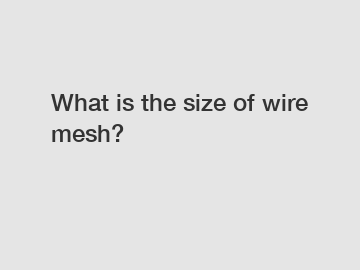What is the size of wire mesh?
When it comes to wire mesh, size matters. The size of wire mesh can greatly impact its effectiveness and suitability for different applications. Understanding the size of wire mesh can help you make informed decisions when choosing the right mesh for your needs.
Wire mesh is a versatile material that is used in a wide range of applications, from construction and fencing to industrial and agricultural purposes. The size of wire mesh refers to the spacing between the wires in the mesh. This spacing, also known as the mesh opening or aperture, can vary widely depending on the needs of the specific application.
Wire mesh is typically measured in terms of wire diameter and mesh opening size. The wire diameter refers to the thickness of the wire used to make the mesh, while the mesh opening size refers to the distance between the wires in the mesh. These measurements can vary depending on the type of wire mesh being used and the requirements of the application.

Wire mesh is available in a wide range of sizes, from very fine meshes with small openings to larger meshes with larger openings. The size of wire mesh is often measured in terms of mesh count, which refers to the number of openings per linear inch. For example, a mesh with a mesh count of 10 would have 10 openings per linear inch, while a mesh with a mesh count of 100 would have 100 openings per linear inch.
The size of wire mesh can impact its strength, durability, and suitability for different applications. Fine meshes with small openings are often used for filtering and straining applications, while larger meshes with larger openings are used for fencing, construction, and other applications where visibility and airflow are important.
When choosing wire mesh for a specific application, it is important to consider the size of the mesh opening and the wire diameter. The size of the mesh opening will determine the size of particles that can pass through the mesh, while the wire diameter will impact the strength and durability of the mesh.
In addition to size, other factors to consider when choosing wire mesh include the material used to make the mesh, the weave pattern, and any special coatings or treatments applied to the mesh. These factors can impact the performance and longevity of the wire mesh in different applications.
Wire mesh is available in a wide range of materials, including stainless steel, galvanized steel, aluminum, and copper. Each material has its own unique properties and benefits, so it is important to choose the right material based on the specific needs of the application.
In addition to material, the weave pattern of the wire mesh can also impact its performance. Common weave patterns include plain weave, twill weave, and Dutch weave, each of which offers different levels of stability, strength, and filtering capabilities.
Furthermore, wire mesh can also be coated or treated with special finishes to enhance its performance in specific applications. Coatings and treatments can help improve the corrosion resistance, abrasion resistance, and UV resistance of the wire mesh, making it suitable for outdoor or harsh environments.
In conclusion, the size of wire mesh is an important factor to consider when choosing wire mesh for a specific application. By understanding the size of wire mesh and how it can impact performance and suitability for different applications, you can make informed decisions when selecting wire mesh for your needs. Whether you need fine mesh for filtering or larger mesh for fencing, there is a wide range of wire mesh sizes available to meet your needs.
For more information, please visit quarry screen mesh for screening factory, self-clean woven wire screen manufacturer, china quarry screen mesh manufacturer.

Comments
0